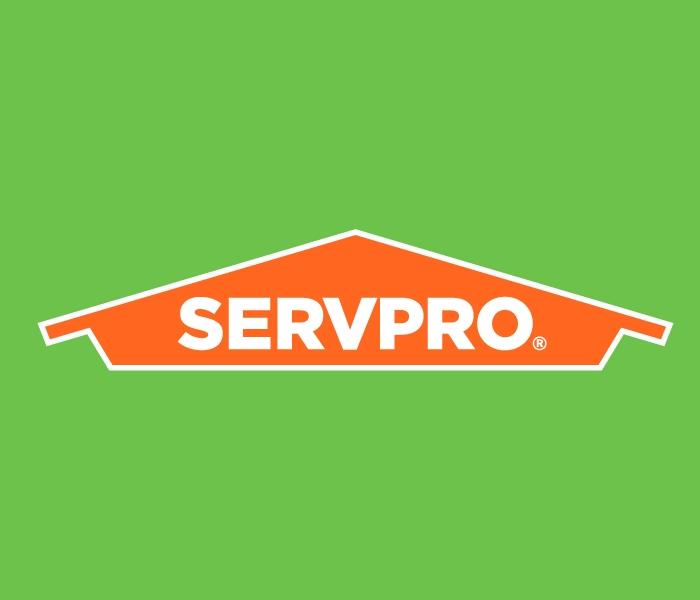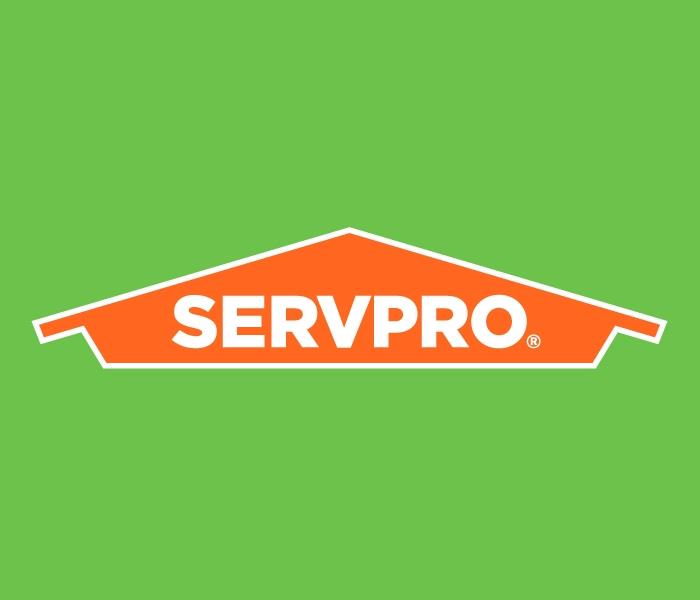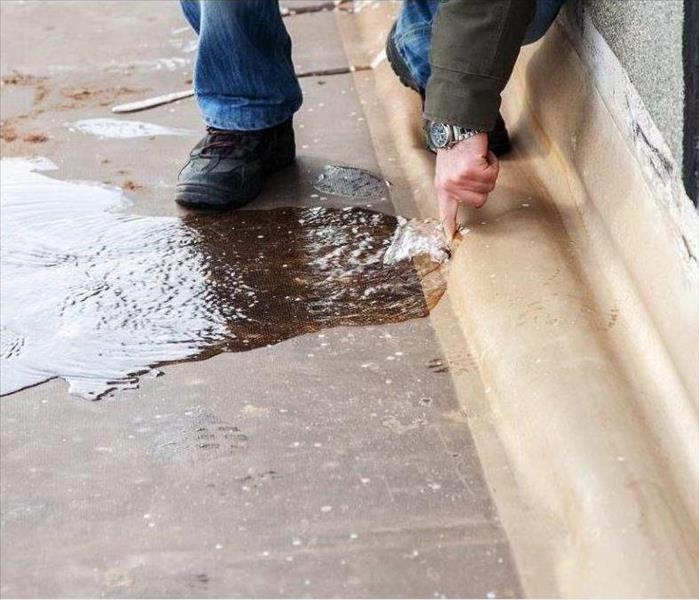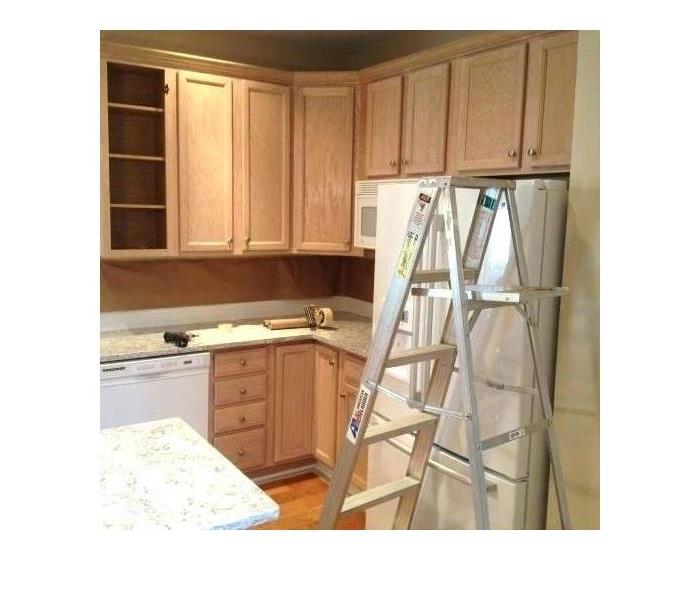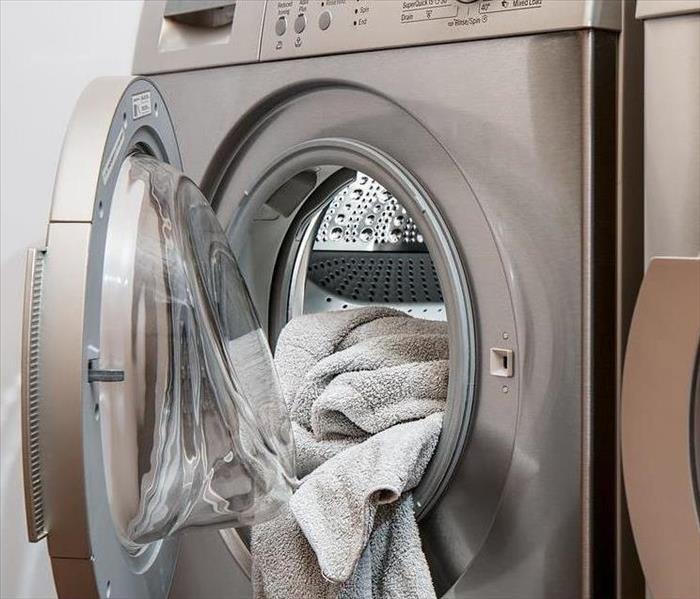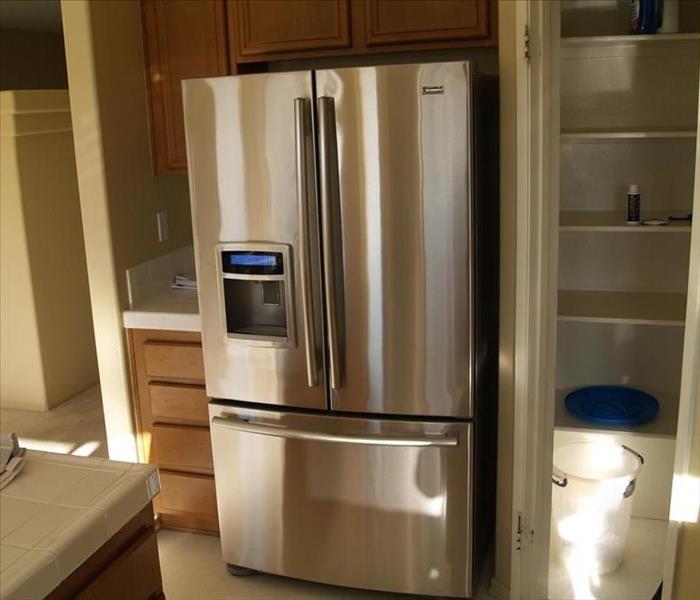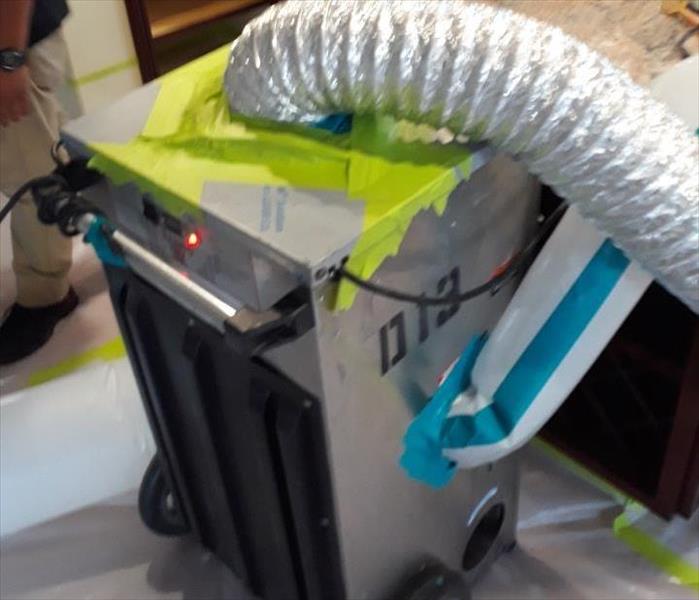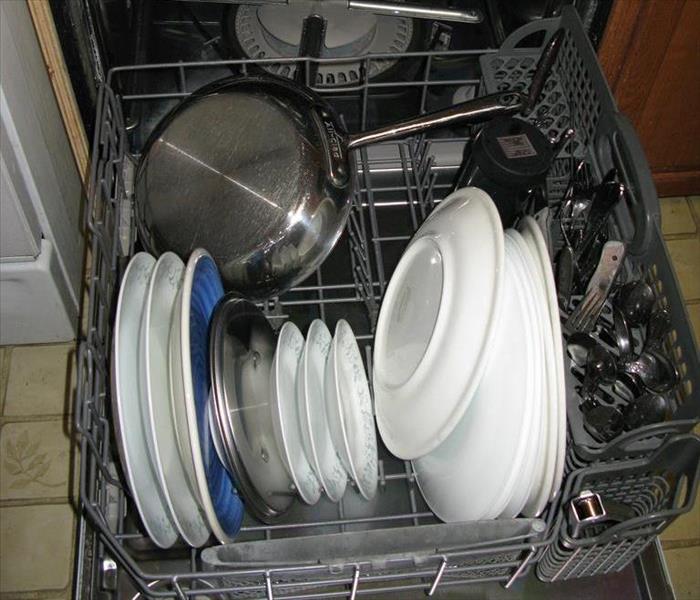Recent Water Damage Posts
Restoring Your Home After Water Damage: How SERVPRO® Can Help
11/22/2024 (Permalink)
Water damage can disrupt your life in an instant, whether it’s caused by a burst pipe, storm flooding, or an overflowing appliance. Beyond the immediate inconvenience, water can severely harm your property and belongings if not addressed quickly and professionally. SERVPRO specializes in comprehensive water damage restoration, bringing expertise, speed, and care to every situation.
Understanding Water Damage
Water damage doesn’t just stop at what’s visible—it can seep into walls, floors, and ceilings, causing structural damage and creating conditions for mold growth. Time is critical when dealing with water damage. The sooner it’s addressed, the lower the risk of long-term problems and costly repairs.
SERVPRO’s Water Damage Restoration Process
At SERVPRO, we use a systematic approach to ensure thorough and efficient restoration of your property:
1. Emergency Response
Water damage requires immediate attention, and SERVPRO’s team is ready 24/7. Our fast response minimizes damage and reduces restoration time.
2. Inspection and Assessment
Our technicians assess the extent of the damage using advanced tools like moisture meters and thermal imaging. This step ensures we identify all affected areas, even those hidden behind walls or under flooring.
3. Water Removal
Using industrial-grade pumps and vacuums, SERVPRO removes all standing water from your property. Rapid water extraction prevents further damage and helps reduce drying time.
4. Drying and Dehumidification
SERVPRO deploys high-powered air movers and dehumidifiers to remove moisture from walls, floors, and other surfaces. Monitoring equipment ensures the space is thoroughly dried to prevent mold growth.
5. Cleaning and Sanitization
Once the area is dry, SERVPRO cleans and sanitizes affected surfaces and belongings. This step eliminates bacteria, odors, and contaminants left behind by the water.
6. Restoration and Repair
From replacing drywall to rebuilding entire rooms, SERVPRO restores your property to its pre-damage condition, ensuring it looks and feels like home again.
Why Choose SERVPRO for Water Damage Restoration?
- Rapid Response: Our team is on call 24/7, ensuring swift action to reduce damage.
- Expert Technicians: SERVPRO’s water damage specialists are certified and trained to handle all levels of water damage.
- Advanced Technology: We use cutting-edge equipment to detect moisture, remove water, and dry spaces efficiently.
- Comprehensive Services: From initial cleanup to complete restoration, SERVPRO manages every step of the process.
- Insurance Expertise: SERVPRO works directly with your insurance company, helping streamline claims and reduce your stress.
Preventing Water Damage
While some water damage is unavoidable, these tips can help reduce your risk:
- Regularly inspect plumbing and appliances for leaks.
- Ensure gutters and downspouts are clear and functioning properly.
- Seal windows and doors to prevent water intrusion.
- Maintain your roof to avoid leaks during storms.
When Water Damage Strikes, Call SERVPRO
Water damage can be overwhelming, but with SERVPRO by your side, you’re never alone. Our skilled team is committed to restoring your property quickly and effectively, so you can return to normal as soon as possible.
Contact SERVPRO Today
Don’t wait—if you’re facing water damage, call SERVPRO for professional help.
Q&A
Q: How long does water damage restoration take?
A: The timeline depends on the extent of the damage. SERVPRO provides an estimated timeline after the initial inspection.
Q: Will my insurance cover water damage restoration?
A: Coverage depends on your policy and the cause of the water damage. SERVPRO works with your insurance provider to document damage and facilitate the claims process.
Q: Can SERVPRO remove water from carpets and furniture?
A: Yes, SERVPRO uses specialized equipment to extract water and clean carpets, upholstery, and other belongings.
With SERVPRO’s expertise, you can trust that your home is in good hands. Let us help you restore what matters most.
Navigating Water Damage with SERVPRO®: Comprehensive Restoration You Can Trust
11/22/2024 (Permalink)
Water damage is a homeowner’s worst nightmare, often occurring unexpectedly and leaving a path of destruction in its wake. From broken pipes to natural disasters, water damage can quickly escalate if not addressed promptly. SERVPRO provides professional water damage restoration services designed to mitigate damage, prevent further issues, and restore your home to its pre-damage state.
The Hidden Dangers of Water Damage
Water damage extends far beyond wet floors and visible stains. Left untreated, it can:
- Compromise Structural Integrity: Prolonged exposure to water weakens walls, ceilings, and floors.
- Create Mold-Friendly Conditions: Mold thrives in damp environments and can grow within 24-48 hours of water exposure.
- Damage Personal Belongings: Furniture, documents, and electronics are especially vulnerable to water damage.
How SERVPRO Responds to Water Damage
SERVPRO combines expertise, cutting-edge technology, and a step-by-step process to deliver effective and efficient restoration.
1. Immediate Emergency Response
When water damage occurs, time is of the essence. SERVPRO’s 24/7 emergency services ensure that help is always just a phone call away.
2. Comprehensive Assessment
Technicians perform a detailed inspection to identify all affected areas and the source of the water. This critical step ensures no hidden moisture is left behind.
3. Swift Water Extraction
Standing water is removed using high-capacity pumps and vacuums, preventing additional damage and speeding up the drying process.
4. Drying and Dehumidification
Industrial-grade dehumidifiers and air movers are strategically placed to eliminate residual moisture from walls, floors, and belongings. SERVPRO carefully monitors this process to ensure complete dryness.
5. Meticulous Cleaning and Sanitizing
To ensure safety and hygiene, SERVPRO cleans and disinfects all affected areas, eliminating contaminants and odors caused by water.
6. Full Restoration
From repairing drywall to replacing flooring, SERVPRO restores your property to its pre-damage condition with care and precision.
Why SERVPRO Stands Out
- Certified Specialists: SERVPRO’s technicians are trained and certified in water damage restoration, ensuring every job meets industry standards.
- Advanced Technology: State-of-the-art equipment helps detect hidden moisture and restore your property more effectively.
- Comprehensive Services: SERVPRO handles everything from initial cleanup to final restoration, giving you one less thing to worry about.
- Insurance Liaison: We work with your insurance provider to streamline the claims process, offering detailed documentation and support.
Protect Your Property from Future Water Damage
Prevention is key to avoiding water damage. Here are a few tips:
- Check for leaks in plumbing and appliances regularly.
- Clean gutters and ensure proper drainage around your home.
- Install a sump pump in flood-prone areas.
- Act quickly at the first sign of water damage to limit its impact.
SERVPRO Is Your Partner in Restoration
Water damage can feel overwhelming, but you don’t have to face it alone. SERVPRO’s skilled team is here to restore your property and bring peace of mind back to your life.
Contact SERVPRO Today
For fast, professional water damage restoration, call SERVPRO now. Let us help you reclaim your home and move forward with confidence.
Q&A
Q: Can SERVPRO handle large-scale water damage?
A: Absolutely. SERVPRO is equipped to manage water damage restoration for properties of all sizes, from homes to large commercial buildings.
Q: Is water damage repair expensive?
A: Costs vary depending on the severity of the damage. SERVPRO provides a detailed estimate after assessing the situation.
Q: What if the water damage is behind walls?
A: SERVPRO uses advanced moisture detection equipment to locate hidden water and address it without unnecessary demolition.
With SERVPRO, you’re not just getting restoration services—you’re gaining a dedicated partner committed to protecting and restoring your property.
Water Damage? Here's How SERVPRO Can Restore Your Property to Perfection
10/18/2024 (Permalink)
Water is essential to life, but when it invades your home or business unexpectedly, it can cause serious damage. Whether it's a burst pipe, flooding, or a slow leak, water damage can disrupt your life, weaken your property, and create long-term issues if not handled quickly. At SERVPRO®, we specialize in water damage restoration, helping homeowners and business owners recover quickly and efficiently after water-related disasters.
The Risks of Water Damage
Water damage can occur in many forms, from small leaks that go unnoticed to sudden, catastrophic flooding. Some of the most common causes include:
- Burst or Leaking Pipes: Aging pipes or sudden bursts can release gallons of water, causing significant damage to walls, floors, and ceilings.
- Flooding: Natural disasters like heavy rains or hurricanes can flood homes and businesses, causing widespread damage.
- Appliance Malfunctions: Dishwashers, washing machines, or water heaters can malfunction, leading to unwanted water spills.
- Roof Leaks: Storms or general wear and tear can create roof leaks that allow water to enter your home.
- Sewer Backups: Sewage backups are not only damaging but may also cause serious health effects.
If left untreated, water damage can lead to:
- Structural Damage: Water weakens wood, drywall, and insulation, potentially compromising the structural integrity of your property.
- Mold Growth: Mold can develop within 24-48 hours of water exposure, creating potential health effects and further damaging your property.
- Electrical Hazards: Water and electricity are a dangerous combination. Flooding and leaks near electrical systems can create serious risks.
- Permanent Stains and Odors: Water can cause staining on furniture, flooring, and walls, leaving behind musty odors that are hard to remove.
Why Immediate Action is Critical
When it comes to water damage, time is of the essence. The longer water sits, the more damage it can cause. That's why SERVPRO offers 24/7 emergency response. Our certified professionals are ready to tackle water damage at any hour, minimizing the destruction and restoring your property to its pre-damage state.
SERVPRO’s Water Damage Restoration Process
At SERVPRO, we follow a proven, step-by-step process to ensure your property is fully restored after water damage:
Emergency Contact
Once you contact us, we respond quickly, assessing the situation and dispatching a team to your location.
Inspection and Damage Assessment
Our team conducts a thorough inspection to determine the extent of the water damage. We use advanced moisture detection equipment to identify areas that are damaged but may not be immediately visible, such as behind walls or under flooring.
Water Removal/Extraction
Using powerful pumps and vacuum units, we remove hundreds or even thousands of gallons of water from your property. This immediate water extraction helps prevent further damage and reduces drying time.
Drying and Dehumidification
Even after the bulk of the water is removed, walls, floors, and furniture may still retain moisture. We use industrial-grade dehumidifiers and high-speed air movers to thoroughly dry the affected areas, preventing mold growth and warping.
Cleaning and Sanitizing
Water damage often leaves behind dirt, bacteria, and unpleasant odors. SERVPRO cleans and sanitizes all surfaces and belongings to ensure a safe and healthy environment. We use antimicrobial treatments to prevent future mold growth and remove any lingering odors with professional-grade deodorizers.
Restoration and Repairs
Depending on the extent of the damage, restoration may involve minor repairs such as drywall replacement or major reconstruction projects. SERVPRO handles everything from start to finish, ensuring your property is restored to its original condition, "Like it never even happened."
Why Choose SERVPRO for Water Damage Restoration?
Experienced and Certified Technicians
Our technicians are IICRC-certified (Institute of Inspection Cleaning and Restoration Certification) and undergo rigorous training to ensure they can handle any water damage situation.
Advanced Equipment
SERVPRO uses state-of-the-art equipment for water extraction, drying, and dehumidification. Our advanced moisture detection tools allow us to locate hidden water damage and ensure thorough drying.
Insurance Coordination
Water damage can be overwhelming, and the last thing you want to deal with is complicated insurance paperwork. SERVPRO works directly with your insurance company to help streamline the claims process, ensuring you get the support you need.
Local and Trusted
With locations across the country, SERVPRO is a trusted local restoration expert, always ready to help our neighbors during their time of need.
Preventing Future Water Damage
While water damage is often unexpected, there are steps you can take to reduce your risk:
- Regularly inspect pipes, appliances, and your roof for signs of leaks or wear.
- Install a sump pump in areas prone to flooding.
- Seal cracks in your foundation or basement.
- Consider installing water leak detection devices.
- Keep gutters and downspouts clear to ensure proper water drainage.
Conclusion
When water damage threatens your home or business, you need a team that’s fast, reliable, and thorough. At SERVPRO, we combine cutting-edge technology with decades of experience to provide water damage restoration that restores your property and peace of mind.
If you're facing water damage, don’t wait—contact SERVPRO today for an immediate response and professional restoration service. Let us help you dry up the damage and restore your property to its full potential.
Managing Water Flood Damage: A SERVPRO Solution
10/5/2023 (Permalink)
Water flood damage is a devastating and overwhelming experience for any homeowner. Whether it's from natural disasters like heavy rain or burst pipes within the home, the consequences can be severe and require immediate attention. Water damage can weaken the structural integrity of a building, damage personal belongings, and create a breeding ground for mold and mildew.
In such dire situations, SERVPRO®, a renowned restoration and cleaning services company, emerges as a beacon of hope. They possess the expertise, tools, and dedication to efficiently address the water damage crisis. SERVPRO begins by conducting a thorough assessment to determine the extent of the damage. This step helps in devising a comprehensive plan for restoration.
Their skilled technicians employ advanced equipment to extract excess water and dry out the affected areas. Using air movers, dehumidifiers, and moisture detection devices, they ensure that every nook and cranny is thoroughly dried to prevent further damage and microbial growth. SERVPRO also assists in salvaging and restoring personal belongings affected by the flooding.
What sets SERVPRO apart is their commitment to not only restoring the physical damage but also offering guidance on preventing future occurrences. They educate homeowners on best practices for water damage prevention and recommend necessary steps to safeguard their properties against potential risks.
In conclusion, dealing with water flood damage requires prompt and professional intervention. SERVPRO stands as a reliable ally in times of crisis, offering the expertise and resources needed to restore homes and lives to their pre-flood condition. Their dedication and efficiency make them a go-to solution for those grappling with the aftermath of water damage.
Water Damages and what to do?
8/23/2022 (Permalink)
What actually occurred?
The plastic water line behind the refrigerator frequently cracks, starting a sluggish trickle that accumulates water behind the refrigerator unseen. Excessive condensation buildup is another typical cause that has the same result. Numerous issues can arise in your house as a result of water damage from your refrigerator, especially given how long the issue may go unnoticed before it is discovered and how much damage has already been done to your floors and the surrounding surroundings. Mold can grow and your floors can deteriorate in the ideal conditions of moisture, heat, and darkness. These mould spores can be problematic in places like apartments or enclosed spaces, and a condition like this should not be disregarded. Since SERVPRO specialises in mould remediation, we will gladly get rid of the problem and stop any future aggravation for you.
Next, what?
Any visible water must first be cleaned up to prevent further damage and the possibility of mould growth. After doing this, check your refrigerator to see if there are any obvious leaks or places where excessive condensation may be accumulating. If feasible, it's critical to replace any damaged connections in order to immediately halt the leak. Examine the damage to the area under and around the refrigerator if you are able to. The majority of the time, damage to the floors will be obvious, but the underlying issues may be hidden beneath.
what happens to water?
8/23/2022 (Permalink)
What Happens to the Water Now?
When a leak develops, it can be frustrating to try to determine where the water goes. It's important to know the right procedures to take when a leak is discovered coming from an appliance or an open entryway (window, door, hole).
It's considerably more challenging to manage in the case of multi-unit buildings, such as co-ops or apartment complexes. To choose an appropriate water restoration solution, it is vital to determine the path of the water. Since each apartment is normally plumbed separately yet shares walls, ceilings, and floors with other living spaces, multi-unit housing is a natural place for such detective work. When it is quite likely that the water from the leak eventually spreads throughout the building where you cannot even see it and other tenants have not yet noticed, it is insufficient for a landlord to just respond to the complaint of one tenant.
Is It Simple to Track Water's Movement from Space to Space?
Water is frequently said to follow the route of least resistance. This fact does not always stand up to inspection because there are many additional considerations. For instance, if condensation forms on a cold water supply pipe running parallel to the floor in a warm, damp basement, some water will drop in a line down the pipe's length and fall to the ground. There would be numerous damp places traced on the floor throughout the length of the pipe, as opposed to simply one wet spot. The condensation will, however, have a tendency to run down the pipe and collect in a circle at the bottom if the cold pipe is parallel to the floor. Additional cases may yield even more contrasting solutions.
Now Tell Me How Trained Technicians Follow the Water
Since water doesn't go along the same paths that people might assume from mythology, SERVPRO needs to come up with more dependable methods of figuring out where water travels and hides. During the Institute of Inspection, Cleaning, and Restoration Certification (IICRC) training, our specialists learn the fundamental techniques for detecting moisture. We employ moisture detectors with and without prongs to find the presence of moisture, which aids us in tracing the path of an intrusion by water. We also use specialised moisture metres to measure the amounts of water absorbed by porous materials for further data. After we remove any standing water, the moisture levels serve as baselines for our Applied Structural Drying (ASD) professionals as they decide what drying goals to set.
Why Is It Important? Shouldn't the Water Inside the Building Just Dry Up?
One of the worrying possibilities to think about is the potential for mould development if all water is not removed from every area of an apartment complex. Only a minimal amount of moisture is required for mould spores to "germinate" and start growing. Molds only require oxygen, water, and an organic surface on which to grow. Mold colonies can grow without light in any building cavity, above ceilings, and between walls. Landlords are required to locate the leak and make plans to remove all water as soon as one occurs due to the risk of mould damage when wood framing, drywall, ceiling tiles, and other building materials are even slightly wet.
How Do Experts Remove Water From Tight Spaces?
Even in a large apartment complex, portable extractors can be moved quite a distance inside the flats. Compared to the larger, more powerful truck-mounted models, the mobile units are significantly more adaptable in their usage and can fit in confined locations much more readily. Up to 12 litres of water can be extracted using the equipment before it needs to be drained and a new attempt made to remove as much water as is possible. The apparatus can be carried like a backpack. We must take into consideration various controlled removal procedures, such as drilling access holes into the walls, if the extractor cannot reach moisture even with extenders.
Dealing with Water Floods
8/23/2022 (Permalink)
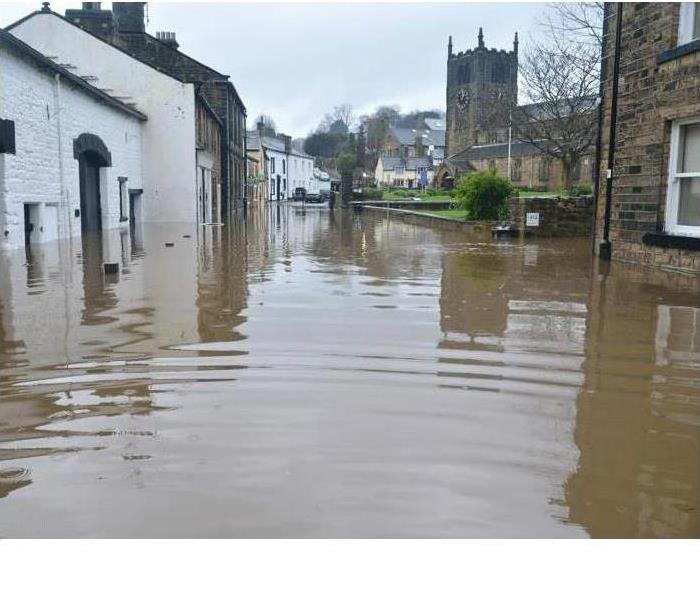 Water flood
Water flood
How to Stay Safe During a Flood
Water can enter your home during a storm and cause flooding, which can seriously harm your property. However, ensuring the protection of your immediate family, pets, and other loved ones should always come first. When the weather is safe, return to inspect the damage and start the cleanup once the storm has passed. When visiting the floodplain, avoid doing the following things:
Keep Your Hands Off the Water.
Numerous forms of contaminants, such as bacteria, viruses, chemicals, and debris, can be found in floodwater. Wearing rubber boots, gloves, and avoiding getting your hands or face wet will help protect your skin from the damaging effects of the water. If, in spite of your best efforts, contact happens, wash right away with soap and fresh water.
Never step into standing water.
Homes, yards, roadways, and other locations may have standing water after a flood. It is not unusual to see downed powerlines following a storm because strong winds frequently accompany intense storms. You can't always discern what's underneath the surface because floodwater is typically murky. If you enter a flooded home, you can get an electric shock if the water has been electrically charged. The risk of electrocution will be reduced with the use of rubber boots.
Don't let the water stand still.
Bacteria have more time to grow the longer water sits. The structural integrity of objects might start to deteriorate if they are submerged in water over extended periods of time. As quickly as possible, the water should be carefully evacuated. You can limit any water damage to your home by clearing the water more quickly. As soon as the water has been removed from the area, you should start the drying process because mould can start to form in as little as 24 to 48 hours.
By following a few precautions, you can help keep yourself safe from the dangers of floodwater.
Advice on what to do after facing water flood
8/23/2022 (Permalink)
Floods in your building can be terrible; we understand how stressful and frustrating this can be. However, there are certain things you can do in the first 24 hours after a flood if you follow our advice.
- Take photos of the damage before removing any water. This will help your insurer understand the extent of the damage.
- Protect Your Health: Sewage or home chemicals could contaminate the water. Wear rubber gloves if you plan on lingering near the water.
- Contact your insurance provider: Notify your insurance company as soon as possible after the flood. Keep the phone numbers of your insurance company and local agent in your phone for emergencies.
- Remove Water: Once your insurer has given you permission to do so, utilise a sump pump and contact a restoration business.
- Mold can develop in as little as 24 to 48 hours after a flood. Make sure to rapidly remove any moist contents, such as carpets and bedding.
Flooding at your home or company necessitates the assistance of an expert. To get it repaired as soon as possible, contact your local restoration firm.
What to do after water damage
2/1/2022 (Permalink)
What to do after water damage;
One of the most damaging and devastating things you can experience as a homeowner is water damage. Whether it is due to flooding, burst pipes, sewer backups, roof damage due to severe storms or a leaky toilet when you are out of town – all can cause majorwater damagein your home. No matter what the cause, it is important to have a plan of action and know what you should do if your house floods. In fact, taking swift action can significantly improve your ability to reduce the costs of repair. Here’s what you should do after you experience water damage that will help reduce the amount of damage after and will make clean-up and repair easier.
Avoid additional risk;
If the water damage was serious enough for you to have to evacuate your home, be sure you and your family remain safe upon your return. Agencies like the Federal Emergency Management Agency (FEMA) advises that you should check for the following things you’re your return to ascertain if it is safe to occupy your home:
If insured, contact your Insurance Company
No matter if you are experiencing water damage from a flood or leaky toilet, you should contact your insurance company ASAP. In fact, it’s a good idea to have their number in your phone so you are not searching for their contact information during a highly stressful time. Remember, time is of the essence! In cases where flooding is affecting a widespread area, your agent may be handling multiple homeowners (or even their own). If you find yourself having a hard time getting in touch with your agent, contact the insurance company’s headquarters.
Once you are in touch with your insurance representative, the first thing you need to do is disclose the state of your home. Make sure you take diligent notes regarding the conversation and follow their direction about whether to wait for an adjuster to inspect the property before making repairs. You will most likely find new damage that will require multiple conversations, so be sure to document EVERYTHING!
In most cases your insurance company will advise you to contact your local Restoration Company.
We at SERVPRO ofDowntown Long Beach are preferred vendor with most Insurance Companies. Our technicians are available 24/7 to assist with any size water damage you may experience.
FAQ: I AM A RENTER-WHO WILL PAY FOR THIS WATER DAMAGE REPAIR?
1/31/2022 (Permalink)
At SERVPRO of Downtown Long Beach/Signal Hill, we have the opportunity to work on many water damage properties where multiple parties are involved. We often have renters, homeowners, property managers, and HOAs on a single water damage repair. Each project is unique when it comes to water restoration for condos or homes. Renters are responsible for their belongings, except in rare cases where the landlord's policy covers rental belonging. If a renter has a rental insurance policy, the policy may cover damaged contents (furniture, clothing, personal items), temporary housing if needed, or cleaning your belongings. The homeowner is responsible for the structure of the property. HOAs may be responsible for some of the structural repairs, depending on how the association bylaws are written.
Part of our job at SERVPRO of Downtown Long Beach/Signal Hill is to guide you through this process. We do water damage repairs every day, 24/7, so it is our pleasure to help you recover after a water emergency. Our team is trained to help you file a claim and communicate with your landlord and property manager. Please call SERVPRO at 888-591-1733 and we will help you with the water damage repair at your condo, home, or business.
Floods And Damage Across Several States
8/20/2021 (Permalink)
Storms and heavy rains can cause heavy flooding in a short period of time. Certain parts of the country experienced heavy rains earlier this year. People experienced dangerous storm water and flood damage in 6 states in early March. The National Weather Service is warning that rivers will stay in flood stage for days. The flood waters forced evacuations and millions in damage.
After The Flooding
Flooding means that not only will a homeowner have to think about the current situation of being displaced from their home and losing some of their personal belongings, but the results after the water is gone. Standing water is a breeding ground for bacteria.
Once the water has subsided the presence of dirt, grime, bacteria and mold will be present. The level of expensive damage depends on how long the standing water is left unattended. There is no telling when the water can be extracted from the towns let alone people’s houses.
After the waters have subsided and before you immediately enter your home refer to this checklist.
1. Watch out for wild animals, poisonous snakes that may have entered the home, check thru the debris.
2. Watch out for plaster, loose ceiling structures and document everything for yourself and for insurance purposes.
3. Throw away any food, anything that may have come in contact with the flood waters, anything in the fridge.
4. Check electrical systems, gas leaks, sewage and water lines all for damage.
Call SERVPRO Even if your flood damage is not as dramatic as what we saw in the south earlier this year, we'll be there to help.
Damage from Clean Water
8/20/2021 (Permalink)
- Shut off the water source if possible or contact a qualified professional to do so.
- Turn off circuit breakers for wet areas of the building, if access to the power distribution panel is safe from potential electrical shock.
- Remove as much excess water as possible by mopping and blotting.
- Wipe excess water from wood furniture after removing lamps and tabletop items.
- Remove and prop up wet upholstery cushions for even drying.
- Place aluminum foil or wood blocks between furniture legs and wet carpeting.
Damage from Contaminated Water:
- Avoid all contact with sewage and items contaminated by sewage.
- Do not walk through contaminated areas, as you could spread damage to unaffected areas.
- Do not turn on HVAC system if there is a possibility of spreading contaminated air.
- Do not use household fans to dry the structure; air flow could spread contaminants.
- Discard any food and/or products for personal hygiene and cleanliness if exposed to the contaminated areas.
SERVPRO is here to help. Give us a call if you have water damage
We are available 24 hours a day for water emergencies, large or small. When you are dealing with water damage, immediate action is crucial. A delay of just a few hours can greatly increase the severity of the water damage.
We understand that when you call us, you may be feeling confused, stressed, and vulnerable. You need an expert to guide you through this crisis. SERVPRO has the specific water damage training and experience to help you through this tough time. We specialize in water damage restoration—in fact, it's the cornerstone of our business.
A Flooded Basement Can Lead To Structural Issues And Mold
8/20/2021 (Permalink)
A basement can flood at any time, although flooding most often occurs during heavy rainfall. Basements are inherently prone to flooding because they are the lowest level of a building and are normally built partly or entirely below ground level.
There are a number of reasons why your basement could flood, including:
A blocked or failed sewer lateral pipe
Heavy rain causes surface water to pool around your home
Storm sewer backup
Sanitary sewer backup
Foundation drainage failure
Water supply-line break or hot-water tank failure
Have Questions about Basement Flooding?
Call us Today
If flood water is not handled quickly and properly, it can cause severe damage to your home’s structure. Remember, the longer you wait, the worse the problem will get. Mold is also a threat if the water damage isn't treated.
If your home or business has a mold problem, we can inspect and assess your property and use our specialized training, equipment, and expertise to remediate your mold infestation.
If You See Signs of Mold, Call Us Today
A flooded basement can jeopardize your safety, and your home’s integrity.
We are Flooded Basement Specialists:
We are Available 24 hours/7 days per week
We’re a Preferred Vendor to many National Insurance Companies
We Bill the Insurance Directly – One Less Thing For You To Worry About
Our Technicians are Highly Trained in Water Restoration Techniques
We use s500 IICRC Restoration Standards
Advanced Inspection and Extraction Equipment
SERVPRO technicians are available to help.
Heavy Rains, Flash Floods And Water Damage
8/20/2021 (Permalink)
Flooding And Water Damage To Your Home
Weather patterns in your area can be unpredictable. Flash flooding, heavy rains, and road closures are part of life in the metro area.
Sometimes floods develop slowly and forecasters can predict where a flood will happen well in advance.
There are times that flash floods occur in minutes and even on occasion, without any sign of rain. The National Weather Service (NWS) believes being prepared can save your life and give you peace of mind.
National Weather Service recommends following these tips before a flood:
1. If you have access to sandbags or other materials, use them to protect your home from flood waters if you have sufficient time to do so. Filling sandbags can take more time than you may think.
2. Have a professional install check-valves in plumbing to prevent flood waters from backing up into the drains of your home. Make sure your sump pump is working and consider having a backup. Make sure your electric circuit breakers, or fuses, are clearly marked for each area of your home.
3. Since standard homeowners insurance doesn't cover flooding, ensure coverage by contacting your insurance company or agent to purchase flood insurance. This must be done before there is even a threat of flooding as insurance companies stop issuing policies if there is a threat of flooding. (i.e. an approaching hurricane). Many flood insurance policies take at least 30 days to go into effect so even if you can buy it as a storm is approaching, it may not protect your investment.
Water Damage | What is Covered Under Rental Insurance?
8/20/2021 (Permalink)
Depending on the type of policy, Renters insurance protects you against water damage caused by a number of situations that you may experience as a tenant in Montgomery County, such as accidental overflows or water discharge.
Accidental water damage incidents include:
- Pipe burst
- Machine malfunction (dishwasher, washing machine, etc)
- Plumbing.
- Damage to neighboring units
What Is My Landlord Responsible For?
Your landlord is responsible for the maintenance of your rental home, which includes preventing and fixing leaks. Any flaw in the building that could be linked to a possible future cause of property damage and water damage repairs must be reported.
Almost all rental agreements claim that you are not responsible for water damage repairs that are caused by structural issues if you inform your landlord in writing as soon as you find them. This involves leaks in the ceiling, assuming you aren't the one who caused them.
Double-Check Your Lease And Your Renter Policy
Although most policies cover losses caused by accidental water damage, call your insurance company and discuss what your rental insurance covers. Also, read your lease carefully. Make sure you understand your and those of your landlord's responsibilities in the event of a crisis. And in times of emergency, make sure your landlord knows to call SERVPRO of Washington, DC when water damage restoration services are needed.
FAQ: I AM A RENTER-WHO WILL PAY FOR THIS WATER DAMAGE REPAIR?
1/14/2021 (Permalink)
At SERVPRO of Downtown Long Beach/Signal Hill, we have the opportunity to work on many water damage properties where multiple parties are involved. We often have renters, homeowners, property managers, and HOAs on a single water damage repair. Each project is unique when it comes to water restoration for condos or homes. Renters are responsible for their belongings, except in rare cases where the landlord's policy covers rental belonging. If a renter has a rental insurance policy, the policy may cover damaged contents (furniture, clothing, personal items), temporary housing if needed, or cleaning your belongings. The homeowner is responsible for the structure of the property. HOAs may be responsible for some of the structural repairs, depending on how the association bylaws are written.
Part of our job at SERVPRO of Downtown Long Beach/Signal Hill is to guide you through this process. We do water damage repairs every day, 24/7, so it is our pleasure to help you recover after a water emergency. Our team is trained to help you file a claim and communicate with your landlord and property manager. Please call SERVPRO at 888-591-1733 and we will help you with the water damage repair at your condo, home, or business.
WATER DAMAGE: THE SCIENCE OF DRYING
1/14/2021 (Permalink)
The Science of Drying
When faced with water damage, we might instinctively reach for towels to dry the wet. We might add fans to aid the process. However, there is actually a science to the drying process. The knowledge of psychrometrics, the dynamics of moist air, is critical to lower the chances of secondary damages. Your IICRC certified and trained technicians at SERVPRO of Downtown Long Beach/Signal Hill know the steps to take when your business or residence experiences water damage:
- First, we’ll conduct an inspection to detect what material(s) are wet
- Next, we’ll measure how much moisture is in those wet components and monitor whether the materials are drying properly.
- Additionally, we’ll "speed up" the process by using professional drying equipment. While a wet building can often dry naturally, it might do so unevenly, inadequately, or might take too long…all allowing for secondary damages to occur.
SERVPRO of Downtown Long Beach/Signal Hill has the knowledge, advanced equipment, and the technology, DryBook (a proprietary tool that provides real-time documentation, updates on the drying process, and confirms industry drying requirements are met) to ensure that your water damage is mitigated. We’ll make it “Like it never even happened.”
WATER DAMAGE: THE SCIENCE OF DRYING Water
12/8/2020 (Permalink)
When faced with water damage, we might instinctively reach for towels to dry the wet. We might add fans to aid the process. However, there is actually a science to the drying process. The knowledge of psychrometrics, the dynamics of moist air, is critical to lower the chances of secondary damages. Your IICRC certified and trained technicians at SERVPRO of Downtown Long Beach/Signal Hill know the steps to take when your business or residence experiences water damage:
- First, we’ll conduct an inspection to detect what material(s) are wet
- Next, we’ll measure how much moisture is in those wet components and monitor whether the materials are drying properly.
- Additionally, we’ll "speed up" the process by using professional drying equipment. While a wet building can often dry naturally, it might do so unevenly, inadequately or might take too long…all allowing for secondary damages to occur.
SERVPRO of Downtown Long Beach/Signal Hill has the knowledge, advanced equipment, and the technology, DryBook (a proprietary tool that provides real-time documentation, updates on the drying process, and confirms industry drying requirements are met) to ensure that your water damage is mitigated. We’ll make it “Like it never even happened.”
Water Damage can be unexpected
8/2/2020 (Permalink)
SERVPRO is available 24 hours a day for water emergencies, large or small. When you are dealing with water damage, immediate action is crucial. A delay of just a few hours can greatly increase the severity of the water damage.
We understand that when you call us, you may be feeling confused, stressed, and vulnerable. You need an expert to guide you through this crisis. SERVPRO has specific water damage training and experience to help you through this tough time. We specialize in water damage restoration—in fact, it is the cornerstone of our business.
What to Expect
When you call us, we will ask questions regarding your water damage emergency. These questions will help us determine what equipment and resources to bring. This includes how many trained SERVPRO professionals we may need.
Our SERVPRO Representative will ask questions:
- Your name and contact information
- Your insurance information (if applicable)
- The street address of the water-damaged home or business
- When did the flooding or water damage occur?
- What caused the water damage (if known)?
- Is there electricity available (on-site)?
We faster to any Water disaster
8/2/2020 (Permalink)
SERVPRO provides 24/7/365 fire and water damage restoration service.
We do not wait for regular business hours. SERVPRO provides emergency cleaning and restoration services 24 hours a day, 7 days a week—including all holidays.
Faster To Any Size Disaster
Flooding and water damage are invasive. Water quickly spreads throughout your home and gets absorbed into floors, walls, furniture, plus more. SERVPRO arrives quickly and starts the water extraction process almost immediately. This immediate response helps to minimize the damage and the cleaning and restoration costs.
Water quickly spreads throughout your property, saturating everything in its path.
Water is absorbed into walls, floors, upholstery, and belongings.
Furniture finishes may bleed, causing permanent staining on carpets.
Photographs, books, and other paper goods start to swell and warp.
Hours 1 - 24:
Drywall begins to swell and break down.
Metal surfaces begin to tarnish.
Furniture begins to swell and crack.
Dyes and inks from cloth and paper goods spread and stain.
A musty odor appears.
48 Hours to 1 Week:
Mold and mildew may grow and spread.
Doors, windows, and studs swell and warp.
Metal begins to rust and corrode.
Furniture warps and shows signs of mold.
Paint begins to blister.
Wood flooring swells and warps.
Serious biohazard contamination is possible.
More Than 1 Week:
Restoration time and cost increase dramatically; replacing contaminated materials and structural rebuilding may be extensive.
Structural safety, mold growth, and biohazard contaminants pose serious risks to occupants.
WASHING MACHINE WATER DAMAGE: COMMON CAUSES
8/1/2020 (Permalink)
Washing machines are one of the most common sources of water damage in the home, and the damage can be costly, reaching potentially thousands of dollars.
Since each washing machine has multiple ways of causing water damage with multiple components that break down, we have made a list of parts that most commonly cause leaks:
- Plugged floor drain: Before disassembling your washing machine, check that the floor drain is clear of debris like lint that can build up over time. Water on your floor may be the result of a clogged drain and not an issue with the washer itself.
- External supply hoses: Start a fill cycle on your machine and look for drips around the water supply connection hose. If the hoses themselves seem to be free of corrosion or rust but are still dripping, try replacing the internal washers to create a tighter seal.
- Internal hoses: If the supply hoses aren’t leaking, check the internal hoses that connect the inlet valve to the tub by opening up the washer cabinet. Cracked or perforated hoses may be the problem.
- Seals: Normal wear and tear can cause door boot seals to crack or rip. If your machine is leaking during either the fill or agitation portion of the wash cycle, damaged tub seals could be the cause and will need to be replaced.
If you experience water damage in your Long Beach home as a result of a faulty washing machine, call SERVPRO of Downtown Long Beach/Signal Hill for an expert inspection and cleanup plan. We will fix the source of the problem and reverse the damage caused by faulty appliances. We’re available 24/7 at 562-591-1788.
SAVING A BOOK FROM WATER DAMAGE
8/1/2020 (Permalink)
If you experience flooding or severe water damage in your Long Beach or Lakewood home, rescuing your possessions from a burst pipe or water leak can become a stressful task. For example, finding a sentimental book or album soaking wet could lead you scrambling to dry it in a hurry and reverse the water damage.
In some cases, these items are not permanently ruined. The following tips can help you save a wet book, even if the pages are incredibly weak or completely soaked with water.
- Shake out excess water. Even if the book appears to have water damage, there still may be hope. First, move the wet book to a dry area to prevent further damage. If the book is dripping with water, tightly hold it closed and shake out as much as you can.
- Wipe down the cover. Once the excess water has been removed, use a microfiber cloth to gently wipe down the cover. Avoid wiping the individual pages as they might tear if you apply too much pressure.
- Absorb the water. Lay down a washcloth on a dry, flat area to serve as a base to absorb the water. Just make sure that the material is not dyed, or it will bleed onto the wet book. Take advantage of direct sunlight to reverse the water damage even faster.
- Place the book upright. After setting down the washcloth, set the book to stand upright to allow the water to flow down to the base. While hardcover books will be easy, you can use weights or bookends to prop up paperbacks for support.
- Insert rags behind the covers. Place rags in between the front and back cover only. Avoid placing them in between the pages as they can rip easily.
- Let the book sit. Allow the book to rest in standing position for as long as necessary to dry completely.
With some patience and ingenuity, a valuable book can be saved from water damage. For additional home and business restoration services, SERVPRO of Downtown Long Beach/Signal Hill has you covered every step of the way. Don’t hesitate to contact us for emergency cleaning and flood damage repair. We are able to restore your possessions using our professional equipment to help reduce the cost and stress of replacing them.
HOW TO PREVENT WATER DAMAGE: ON VACATION
8/1/2020 (Permalink)
There may be nothing worse than coming home from a relaxing vacation to a flooded home! Water damage that isn't resolved quickly can turn into a mold problem. When a home suffers a water damage event, a mold infestation can quickly arise and spread throughout the residence in as little as 48-72 hours. Mold can cause health effects and can also cause significant damage to your property. So avoiding water damage while you are away is key vacation prep! Here are a few tips, before you head out, to keep your property dry and, hopefully, damage- free:
-Inspect the hoses that connect to major appliances such as washing machines, dishwashers and refrigerator ice-makers. Replace any old or damaged hoses.
-Clear all the debris out of your rain gutters, and check the downspouts for any blockages. This will enable water to exit your roof correctly without flooding or backing up.
-Ask someone to check on your home periodically while you are away to make sure all goes well. If there is a leak or flood, they’ll catch it in the early stages.
-Consider shutting off automatic sprinklers in the front and back of the house. This will prevent you from having a flood in your yard that can migrate into the property.
-Consider turning off the main water in the house. In this way, you are completely avoiding any in-home water damage from pipes that could possibly burst in your absence.
SERVPRO of Downtown Long Beach/Signal Hill is ready to assist when your home is affected by water damage (fire damage, smoke damage, biohazard too) whether you've been away on vacation or not! Call us 24/7 at 562-591-1788 and let us know how we can help!
How to prevent rain water to enter your house?
12/2/2019 (Permalink)
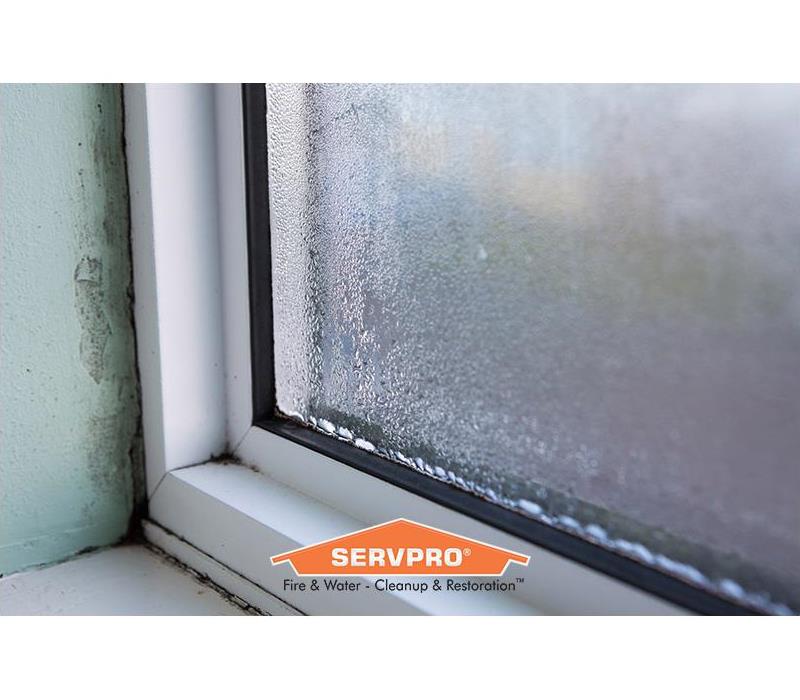 Watering leaking inside the house throws the window.
Watering leaking inside the house throws the window.
Water damage is the worst nightmare for a homeowner. Roof leaks wet basements, and caved in walls are very expensive to fix. Also, no one wants to have the furniture get ruined by water intrusion and mold. That why it’s essential to understand this tip to keep your house safe during winter rainstorms. Here are tips to help you avoid water leaks inside your home.
- Make sure gutters are clean
Dirty gutters they are a severe problem because it prevents the water flow, which is going to make overflowing of water, and that may lead to trickle-down walls and into the house foundation. Always clean the gutters every other week.
- Prevent the landscaping from getting closer to your house
If the garden is getting closer to the home, water will ultimately lead to foundation cracks, and the roots of the plants have the potential of growing into the sprinkler system, drainage, and septic tanks.
- Water bill is the primary key to know if there is a leak inside walls or no.
Always keep an eye on the water bill. If it went to high, that means that there is a leak in one of the pipes and you need an immediate fix because water leaks in walls will lead to cracks and sometimes building falls. look around for caved walls and peeling paint, signs you have water damage within the layers of your walls.
- Never leave connected hoses, not in use
Connected hoses with water in them they might freeze water in pipes and make an ice block that can stop water flow
If you need foundation repairs our professional team at SERVPRO of Downtown Long Beach / Signal Hill can help you fix any leaks and leave your house dry and clean.
SIGNS OF A SLAB LEAK
9/3/2019 (Permalink)
Water damage can occur in a variety of ways, including a slab leak. A slab leak is a term to describe a leak that has developed in the copper water lines running below the concrete foundation of your home. When these same leaks are above ground, in the wall or ceiling, they are known as pinhole leaks.
Slab leaks can wreak havoc on your home and become expensive to repair. The water pipes for your home run through the slab, and as they get old and corrode, or the house settles into its foundation, pipes may spring leaks or break. Check out the signs in this list, so you'll be ready if it happens to you.
There is a visible puddle on the floor
The most common sign of a slab leak is a puddle on the floor that can grow larger over time, as water bubbles up from underneath. You'll often find the puddle close to where plumbing is located, such as the bathroom, kitchen or laundry room. If you see a puddle, look around carefully to make sure the leak isn't actually coming from an appliance.
High Water Bill or Heating Bill
If there is no reason why your water or heating bill is suddenly sky high, you might have a slab leak on your hands. Having a hot water leak in your slab is the same as leaving your hot water running around the clock, which means your hot water heater is also running 24/7, using a ton of electricity or gas.
Warped Wood Floors or Damp Carpet
Water bubbling up from a slab leak accumulates and often comes up under your carpeting or wood floors. Keep an eye out for warped wood flooring or dark or damp areas on your carpet.
If you think you have a slab, don't hesitate to call us 24/7. We will identify the source of the problem, restore your home or business to preloss conditions, and make it "Like it never even happened."
WHAT CAUSES KITCHEN CABINET WATER DAMAGE?
9/3/2019 (Permalink)
Due to all the water lines and drain pipes, your kitchen is one of the most common rooms for water damage. When it comes to water damaged kitchen cabinets, a leak from any one of those water lines can cause significant damage. Some of the most common causes of kitchen cabinet water damage include:
- Leaky pipes under the sink
- Dishwasher floods
- Water supply line issues
- Faucet leaks or malfunctions
- Broken or leaking refrigerator water lines
- Clogged and overflowing sinks
- Excessive condensation from cooking
- Frozen and burst water pipes
In order to prevent water damage in your kitchen, you should check for signs of water damage regularly. Inspect under sink cabinets for signs of leaks and make repairs if necessary. Check dishwasher and refrigerator supply lines at least once per year. Additionally, avoid using plastic water lines when installing a supply line to your refrigerator or ice maker.
If you experience water damage in your Long Beach home, SERVPRO of Downtown Long Beach/Signal Hill is ready to answer your call. Our team is ready to reverse water damage and restore you home and business back to preloss conditions. We are ready to help 24/7.
WASHING MACHINE WATER DAMAGE: COMMON CAUSES
7/29/2019 (Permalink)
Washing machines are one of the most common sources of water damage in the home, and the damage can be costly, reaching potentially thousands of dollars.
Since each washing machine has multiple ways of causing water damage with multiple components that break down, we have made a list of parts that most commonly cause leaks:
- Plugged floor drain: Before disassembling your washing machine, check that the floor drain is clear of debris like lint that can build up over time. Water on your floor may be the result of a clogged drain and not an issue with the washer itself.
- External supply hoses: Start a fill cycle on your machine and look for drips around the water supply connection hose. If the hoses themselves seem to be free of corrosion or rust but are still dripping, try replacing the internal washers to create a tighter seal.
- Internal hoses: If the supply hoses aren’t leaking, check the internal hoses that connect the inlet valve to the tub by opening up the washer cabinet. Cracked or perforated hoses may be the problem.
- Seals: Normal wear and tear can cause door boot seals to crack or rip. If your machine is leaking during either the fill or agitation portion of the wash cycle, damaged tub seals could be the cause and will need to be replaced.
If you experience water damage in your Long Beach home as a result of a faulty washing machine, call SERVPRO of Downtown Long Beach/Signal Hill for an expert inspection and cleanup plan. We will fix the source of the problem and reverse the damage caused by faulty appliances. We’re available 24/7 at 562-591-1788.
HOW A REFRIGERATOR LEAK CAN DAMAGE YOUR FLOOR
7/18/2019 (Permalink)
Since your refrigerator is running 24/7, it can start leaking at the most inconvenient time, resulting in water damage throughout your kitchen. It is important to remain mindful of situations that can cause your refrigerator to leak and catch water damage as soon as it forms.
The Damage Begins Unnoticed
When you are around your refrigerator, you are probably not looking for leaks. Refrigerator leaks tend to start small and gradually grow to become a bigger problem. You might experience a leak coming from the ice maker, a leaky hose, or the water hookup.
Generally, any leaks coming from an ice maker are the result of built-up condensation. This can block the draining system and end up leaking through the inside of your fridge and the seals. In addition, a leaky hose can be the result of having the refrigerator pushed up too close against the wall, bending the hose and causing a break and subsequent leak. When installing, make sure not to push it as far back as possible to avoid damaging the hose. The water hookup can sometimes spring a leak or may drip, which can go unseen for a while and eventually cause problems.
Damage Develops Overtime
Overtime, water leads to breakdown and if undiscovered, could lead to costly repairs. Depending on the type of leak, you can experience rotting floorboards, mold build up, or a flooded basement. A strong indicator of water damage is wood flooring that separates and warps, or tiles that become loose. It is important to repair or replace the floor quickly to prevent mold from growing in the area.
Contact a Professional Restoration Company Immediately
It is important to catch the leak quickly before severe damage occurs. If you suspect a water leak behind your refrigerator or mold growing in your kitchen, call SERVPRO of Downtown Long Beach/Signal Hill for a full inspection. We offer 24/7 emergency response and have trained technicians ready to serve you.
HOW DOES A DESICCANT DEHUMIDIFIER WORK?
7/6/2019 (Permalink)
At SERVPRO of Downtown Long Beach/Signal Hill, we use a variety of equipment to restore water damaged materials and revert your Long Beach property back to preloss conditions. One such piece of equipment that excels at large loss drying is the desiccant dehumidifier.
Desiccant dehumidifiers differ from regular dehumidifiers since they utilize chemical attraction instead of condensation to remove water from the air. They do not collect water in a pan for automatic pump-out. Instead, they produce damp reactivation air, which must be vented outside the structure using temporary ducting. The process is as follows:
- Dehumidifiers absorb moisture from the air into desiccant materials.
- The air to be dried, or processed, is ducted through the rotor in one air stream.
- The rotor brings the moist desiccant to the reactivation air stream to heat it up.
- Moisture is expelled from the desiccant material as water vapor.
- Moist, warm air is ducted outdoors.
- The separate air streams move in different directions, blowing any debris away from the processed air.
- Dried processed air is circulated back into the area.
Desiccant dehumidifiers range in size and configuration dramatically. They can be as small as a roll-on suitcase or as large as two semi tractor-trailers. Large desiccants are often self-contained dehumidification systems, utilizing onboard generators and running on propane or diesel fuel. When large catastrophic events occur, such as hurricanes, large desiccants can provide a means of dehumidification when little or no power is available.
If you experience water damage in your home or business, a desiccant dehumidifier might be used, depending on the extent of water damage. Regardless of the situation, we have the tools to handle the job!
SAVING A BOOK FROM WATER DAMAGE
5/1/2019 (Permalink)
 Water Damaged Book
Water Damaged Book
If you experience flooding or severe water damage in your Long Beach or Lakewood home, rescuing your possessions from a burst pipe or water leak can become a stressful task. For example, finding a sentimental book or album soaking wet could lead you scrambling to dry it in a hurry and reverse the water damage.
In some cases, these items are not permanently ruined. The following tips can help you save a wet book, even if the pages are incredibly weak or completely soaked with water.
- Shake out excess water. Even if the book appears to have water damage, there still may be hope. First, move the wet book to a dry area to prevent further damage. If the book is dripping with water, tightly hold it closed and shake out as much as you can.
- Wipe down the cover. Once excess water has been removed, use a microfiber cloth to gently wipe down the cover. Avoid wiping the individual pages as they might tear if you apply too much pressure.
- Absorb the water. Lay down a wash cloth on a dry, flat area to serve as a base to absorb the water. Just make sure that the material is not dyed, or it will bleed onto the wet book. Take advantage of direct sunlight to reverse the water damage even faster.
- Place the book upright. After setting down the washcloth, set the book to stand upright to allow the water to flow down to the base. While hardcover books will be easy, you can use weights or book ends to prop up paperbacks for support.
- Insert rags behind the covers. Place rags in between the front and back covers only. Avoid placing them in between the pages as they can rip easily.
- Let the book sit. Allow the book to rest in standing position for as long as necessary to dry completely.
With some patience and ingenuity, a valuable book can be saved from water damage. For additional home and business restoration services, SERVPRO of Downtown Long Beach/Signal Hill has you covered every step of the way. Don’t hesitate to contact us for emergency cleaning and flood damage repair. We are able to restore your possessions using our professional equipment to help reduce the cost and stress of replacing them.
WATER DAMAGE FROM A DISHWASHER
3/12/2019 (Permalink)
Have you experienced water damage from a malfunctioning dishwasher? Identifying the source of the problem can become a challenging task. Here we will list common causes for a dishwasher leak, discuss how quickly water damage can occur, explore if it's covered by insurance, and what can be done to fix the problem.
Common causes for a dishwasher leak include the following:
- Worn gaskets
- An dishwasher incorrectly leveled
- Incorrect dish washing soap
- Broken door
- Defective dishwasher tub
How long does it take for damage to occur?
Water leaking from a dishwasher can cause damage within a few hours. Any visible pools of water should be mopped quickly; if it remains on the floor for too long, it can cause permanent damage. Some flooring materials are more susceptible to water damage such as wood or bamboo. For instance, wood will absorb water quickly, causing your flooring to warp and crack.
Is the damage covered by insurance?
Depending on your insurance policy, the damage might be covered. If the dishwasher is new, has shown no previous signs of wear and tear, and you report the damage in a timely manner, your insurer may cover the repair cost. If your dishwasher is old, shows signs of neglect, and has caused you problems in the past, your insurer will likely rule that the water damage is due to negligence on your part and not cover the damages. In addition, we encourage you to view your dishwasher’s warranty to figure out if you can receive a replacement washer free of charge.
Repairing the resulting water damage
Once you notice a malfunction with your dishwasher, make sure to turn it off right away. Call SERVPRO of Downtown Long Beach / Signal Hill, and we can assist with pulling the unit out from under the counter to reach any water that has pooled beneath the machine. Additionally, we can identify the cause of the leak, test for moisture, and schedule any necessary repairs. Let us know how we can help, day or night, at 562-591-1788.
CRAWL SPACE WATER DAMAGE
3/11/2019 (Permalink)
Water damage is incredibly invasive and often reaches a home's crawl space. This is the hollow area found under some houses between the ground and the first floor, roughly one to three feet high. Because it's rare for tenants to access this area, water damage can cause significant damage before the consequences become evident. Here are some common causes for water damage within a crawl space.
Excess Humidity
One possible source of water damage within a crawl space involves excess humidity. Homes with broken window seals or an unsealed crawlspace with a dirt floor will generally have humidity problems. Water can evaporate and become trapped in the crawlspace, resulting in a thin sheet of water. This may then lead to water damage, mold growth, or poor air quality.
Leaky or Broken Pipes
If a puddle of water is found in a crawlspace, a leaky or burst pipe may be the cause. This water could be either clean or contaminated, depending on which pipe it escaped from. A musty smell usually indicates clean water that has been sitting for some time whereas a foul stench may indicate sewage water.
Roof Leak
For homes that have crawl spaces directly attached to the roof, water damage will usually be evident on the ceiling and walls of the crawl space. You may even hear water moving from inside the attic to an inside wall, leading to the crawl space. We recommend calling a professional roofer to locate and patch the leak before addressing crawl space water damage.
What Should be Done if Water Damage is Found in My Crawl Space?
Since a wet foundation, damaged drywall, or sewage leaks can cause serious damage to your home in the first 24-48 hours, we recommend calling us for immediate restoration services. We will identify the source of the damage, use professional equipment to treat the area, and properly handle sewage water or standing water that has bred bacteria. Let us help you determine which materials can be salvaged, and we will repair the affected flooring and drywall.
Call SERVPRO of Downtown Long Beach / Signal Hill 24/7 at 562-591-1788 if you experience water damage within your crawl space.
MONDAY MORNING FLOOD DAMAGE
8/29/2018 (Permalink)
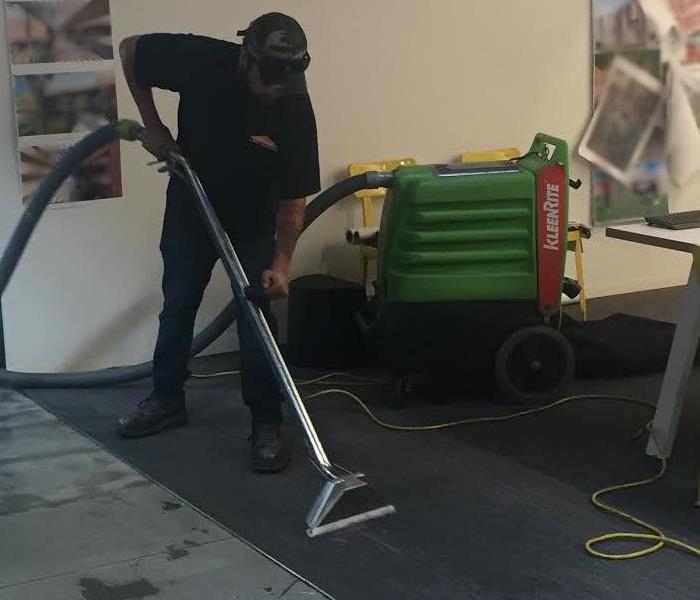 SERVPRO techinician extracting water in a flooded Long Beach business
SERVPRO techinician extracting water in a flooded Long Beach business
Monday Morning Flood Damage
Water damage may occur unexpectedly, through no fault of your own. For example, when a fire hydrant, adjacent to a commercial building, became sheared by a vehicle, it flooded the business without warning and without the occupants’ knowledge or involvement. Did you know a hydrant can gush 5,000 to 180,000 gallons of water, shooting 50 or 60 feet into the air? The amount of water lost depends on response time, hydrant type, and system pressure. If this type of catastrophe occurs, local businesses and residences must be prepared to mitigate a potential flood. On August 27, 2018, one such incident occurred, and SERVPRO of Downtown Long Beach/Signal Hill was quick to arrive on the scene.
On Monday morning, firefighters began pumping water out of a downtown loading dock after a truck driver accidentally sheared a fire hydrant off its base. A big-rig hit the hydrant around 5 a.m. on Long Beach Boulevard, just south of Fourth Street. Fortunately, it activated a fire alarm in the nearby Chuck E. Cheese’s, alerting authorities. That same morning, SERVPRO of Downtown Long Beach/Signal Hill was called to the scene to complete the water remediation in a nearby business affected by the accident. After an assessment of the situation, the SERVPRO crew was quick to suction water out of the floors and carpets, insuring that the facility was thoroughly and professionally dried down. Due to the extent of water damage, impacting numerous offices, computer room, and common area, the entire job was estimated to take about five days.
If your business becomes flooded, there are a few steps you can immediately take to reduce damage before SERVPRO arrives at the scene.
- Turn off power to affected rooms, and walk carefully while avoiding sagging ceilings.
- Find and stop the source. Turn off the valve attached to the leaking fixture, or locate the main water supply valve to the building. If you cannot find the valve, notify a plumber or in some cases, the fire department.
- Remove as much standing water as possible, but only if you’re certain that the water is clean. Do not use a household vacuum cleaner. Instead, use a professional wet/dry vac or towels and linens to prevent the water from entering unaffected areas.
- Remove clothing, documents, and objects in the affected area, and place plastic underneath furniture to prevent further water damage. Wooden blocks or Styrofoam can help protect furniture with a solid base, and curtains can be hung to dry.
- Remove pictures from wet walls and open drawers on wet furniture. Prop up cushions and remove rugs carefully as they may bleed onto other surfaces.
Unexpected flooding is stressful and places your business in a standstill. Whether the source of flooding originated in your building or your neighbor’s, SERVPRO of Downtown Long Beach/Signal Hill is here to help in any emergency, 24/7, and get your business up and running.
HOW TO PREVENT WATER DAMAGE: ON VACATION
7/29/2018 (Permalink)
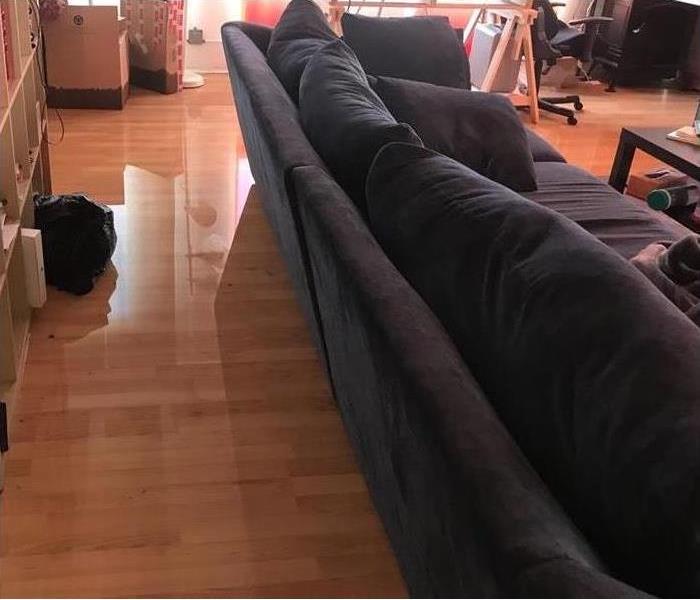 Water Damage to a Long Beach Home
Water Damage to a Long Beach Home
There may be nothing worse than coming home from a relaxing vacation to a flooded home! Water damage that isn't resolved quickly can turn into a mold problem. When a home suffers a water damage event, a mold infestation can quickly arise and spread throughout the residence in as little as 48-72 hours. Mold can cause health effects and can also cause significant damage to your property. So avoiding water damage while you are away is key vacation prep! Here are a few tips, before you head out, to keep your property dry and, hopefully, damage- free:
-Inspect the hoses that connect to major appliances such as washing machines, dishwashers and refrigerator ice-makers. Replace any old or damaged hoses.
-Clear all the debris out of your rain gutters, and check the downspouts for any blockages. This will enable water to exit your roof correctly without flooding or backing up.
-Ask someone to check on your home periodically while you are away to make sure all goes well. If there is a leak or flood, they’ll catch it in the early stages.
-Consider shutting off automatic sprinklers in the front and back of the house. This will prevent you from having a flood in your yard that can migrate into the property.
-Consider turning off the main water in the house. In this way, you are completely avoiding any in-home water damage from pipes that could possibly burst in your absence.
SERVPRO of Downtown Long Beach/Signal Hill is ready to assist when your home is affected by water damage (fire damage, smoke damage, biohazard too) whether you've been away on vacation or not! Call us 24/7 at 562-591-1788 and let us know how we can help!
WATER DAMAGE: THE SCIENCE OF DRYING
7/5/2018 (Permalink)
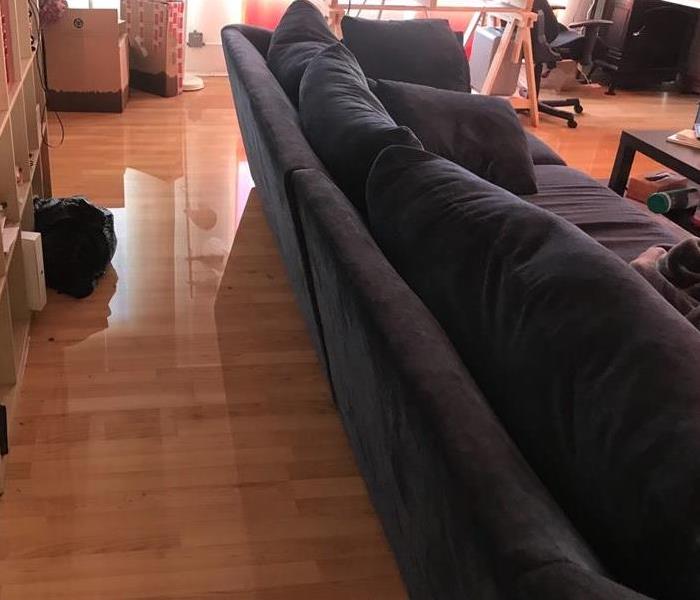 Water damage at a residence in Long Beach
Water damage at a residence in Long Beach
The Science of Drying
When faced with water damage, we might instinctively reach for towels to dry the wet. We might add fans to aid the process. However, there is actually a science to the drying process. The knowledge of psychrometrics, the dynamics of moist air, is critical to lower the chances of secondary damages. Your IICRC certified and trained technicians at SERVPRO of Downtown Long Beach/Signal Hill know the steps to take when your business or residence experiences water damage:
- First we’ll conduct an inspection to detect what material(s) are wet
- Next we’ll measure how much moisture is in those wet components and monitor whether the materials are drying properly.
- Additionally we’ll "speed up" the process by using professional drying equipment. While a wet building can often dry naturally, it might do so unevenly, inadequately or might take too long…all allowing for secondary damages to occur.
SERVPRO of Downtown Long Beach/Signal Hill has the knowledge, advanced equipment and the technology, DryBook (a proprietary tool that provides real-time documentation, updates on the drying process and confirms industry drying requirements are met) to ensure that your water damage is mitigated. We’ll make it “Like it never even happened.”
FAQ: I AM A RENTER-WHO WILL PAY FOR THIS WATER DAMAGE REPAIR?
6/22/2018 (Permalink)
 WATER DAMAGE AT A RENTAL PROPERTY IN LONG BEACH
WATER DAMAGE AT A RENTAL PROPERTY IN LONG BEACH
At SERVPRO of Downtown Long Beach/Signal Hill, we have the opportunity to work on many water damage properties where multiple parties are involved. We often have renters, homeowners, property managers, and HOAs on a single water damage repair. Each project is unique when it comes to water restoration for condos or homes. Renters are responsible for their belongings, except in rare cases where the landlord's policy covers rental belonging. If a renter has a rental insurance policy, the policy may cover damaged contents (furniture, clothing, personal items), temporary housing if needed, or cleaning your belongings. The homeowner is responsible for the structure of the property. HOAs may be responsibility for some of the structural repairs, depending on how the association bylaws are written.
Part of our job at SERVPRO of Downtown Long Beach/Signal Hill is to guide you through this process. We do water damage repairs every day, 24/7, so it is our pleasure to help you recover after a water emergency. Our team is trained to help you file a claim and communicate with your landlord and property manager. Please call SERVPRO at 888-591-1733 and we will help you with the water damage repair at your condo, home, or business.
Your Long Beach/Signal Hill Water Damage Service 24/7
4/26/2018 (Permalink)
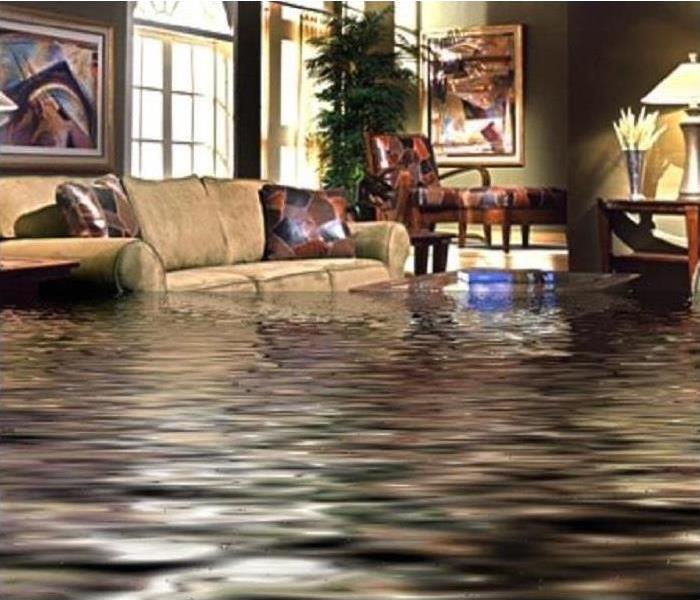 We're available for water emergencies, large or small, 24 hours a day
We're available for water emergencies, large or small, 24 hours a day
SERVPRO of Downtown Long Beach/Signal Hill is available 24 hours a day for water emergencies, large or small. When you are dealing with water damage, immediate action is crucial. A delay of just a few hours can greatly increase the severity of the water damage.
We Answer the Phone Ready to Help
Call Today - 562-591-1788
We understand that when you call us, you may be feeling confused, stressed, and vulnerable. You need an expert to guide you through this crisis. SERVPRO of Downtown Long Beach/Signal Hill has the specific water damage training and experience to help you through this tough time. We specialize in water damage restoration—in fact, it's the cornerstone of our business.
What to Expect
When you call, we will ask several questions regarding your water damage emergency. These questions will help us determine what equipment and resources to bring, including how many trained SERVPRO Professionals may be needed.
Our SERVPRO Representative will ask several questions:
- Your name and contact information
- Your insurance information (if applicable)
- The street address of the water-damaged home or business
- When did the flooding or water damage occur?
- What caused the water damage (if known)?
- Is there electricity available (on-site)?
About SERVPRO of Downtown Long Beach/Signal Hill
SERVPRO of Downtown Long Beach/Signal Hill specializes in the cleanup and restoration of residential and commercial property after a fire, smoke or water damage event. Our staff is highly trained in property damage restoration. From initial and ongoing training at SERVPRO’s corporate training facility to regular IICRC-industry certification, rest assured our staff is equipped with the knowledge to restore your property.
Meet Our Crew-http://www.SERVPROdowntownlongbeachsignalhill.com/employee-photos
Long Beach/Signal Hill: We Specialize in Flooded Basement Cleanup & Restoration!
4/26/2018 (Permalink)
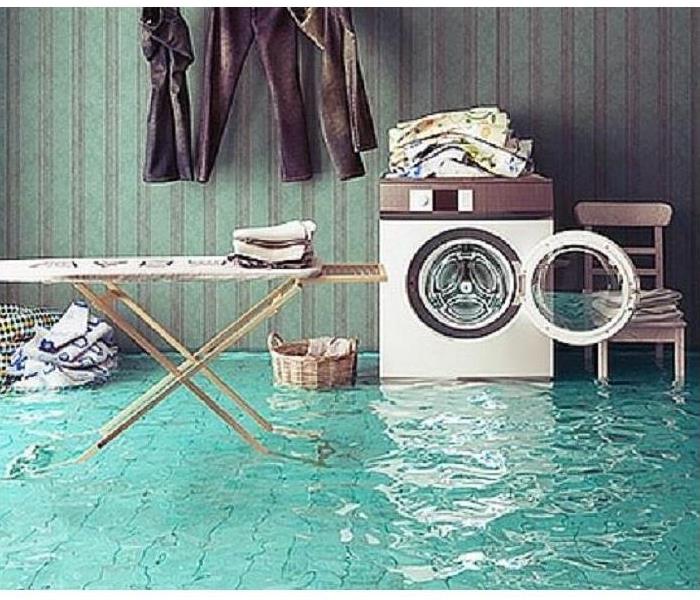 Flooded Basement? We have the trained staff & necessary equipment to solve your problem!
Flooded Basement? We have the trained staff & necessary equipment to solve your problem!
A basement can flood at any time, although flooding most often occurs during heavy rainfall. Basements are inherently prone to flooding because they are the lowest level of a building and are normally built partly or entirely below ground level. There are a number of reasons why your Long Beach or Signal Hill basement could flood, including:
- A blocked or failed sewer lateral pipe
- Heavy rain causes surface water to pool around your home or business
- Storm sewer backup
- Sanitary sewer backup
- Foundation drainage failure
- Water supply-line break or hot-water tank failure
- And many more
Have Questions about Basement Flooding?
Call Today - 562-591-1788
If flood water is not handled quickly and properly, it can jeopardize your health and safety, and cause severe damage to your structure. Remember, the longer you wait, the worse the problem will get.
The bottom line: a flooded basement can jeopardize your health, safety, and your structure’s integrity. It’s worth making a call to SERVPRO of Downtown Long Beach/Signal Hill and let our trained, professional crews handle the situation safely and correctly. We have earned the trust of hundreds of homeowners, business owners, and property professionals.
We are Flooded Basement Specialists:
- We are Available 24 hours/7 days per week
- We’re a Preferred Vendor to many National Insurance Companies
- We Bill The Insurance Directly – One Less Thing For You To Worry About
- Our Technicians are Highly-Trained in Water Restoration Techniques
- We use s500 IICRC Restoration Standards
- Advanced Inspection and Extraction Equipment
Basement Flooded? Call Us Today – We’re Ready To Help 562-591-1788
WATER DAMAGE TIMELINE-FAST ACTION IS KEY!
1/11/2018 (Permalink)
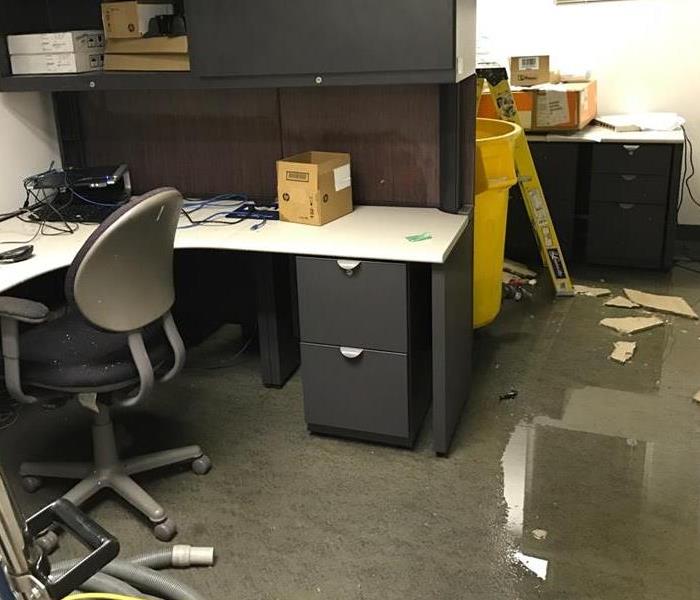 Severe Water Damage in Long Beach Office Building
Severe Water Damage in Long Beach Office Building
Flooding and water emergencies don’t wait for regular business hours and neither do we. SERVPRO of Downtown Long Beach / Signal Hill provides emergency cleaning and restoration services 24 hours a day, 7 days a week—including all holidays.
Faster To Any Size Disaster
Flooding and water damage is very invasive. Water quickly spreads throughout your home and gets absorbed into floors, walls, furniture, and more. SERVPRO of Downtown Long Beach / Signal Hill arrives quickly and starts the water extraction process almost immediately. This immediate response helps to minimize the damage and the cleaning and restoration costs.
Need Emergency Service? Call Us 24/7 –562-591-1788
Water Damage Timeline
Within Minutes
- Water quickly spreads throughout your property, saturating everything in its path.
- Water is absorbed into walls, floors, upholstery, and belongings.
- Furniture finishes may bleed, causing permanent staining on carpets.
- Photographs, books, and other paper goods start to swell and warp.
Hours 1 - 24:
- Drywall begins to swell and break down.
- Metal surfaces begin to tarnish.
- Furniture begins to swell and crack.
- Dyes and inks from cloth and paper goods spread and stain.
- A musty odor appears.
48 Hours to 1 Week:
- Mold and mildew may grow and spread.
- Doors, windows, and studs swell and warp.
- Metal begins to rust and corrode.
- Furniture warps and shows signs of mold.
- Paint begins to blister.
- Wood flooring swells and warps.
- Serious biohazard contamination is possible.
More Than 1 Week:
- Restoration time and cost increase dramatically; replacing contaminated materials and structural rebuilding may be extensive.
- Structural safety, mold growth, and biohazard contaminants pose serious risks to occupants.
About SERVPRO of Downtown Long Beach / Signal Hill
SERVPRO of Downtown Long Beach / Signal Hill specializes in the cleanup and restoration of residential and commercial property after a fire, smoke or water damage event. Our staff is highly trained in property damage restoration. From initial and ongoing training at SERVPRO’s corporate training facility to regular IICRC-industry certification, rest assured our staff is equipped with the knowledge to restore your property.






 24/7 Emergency Service
24/7 Emergency Service
